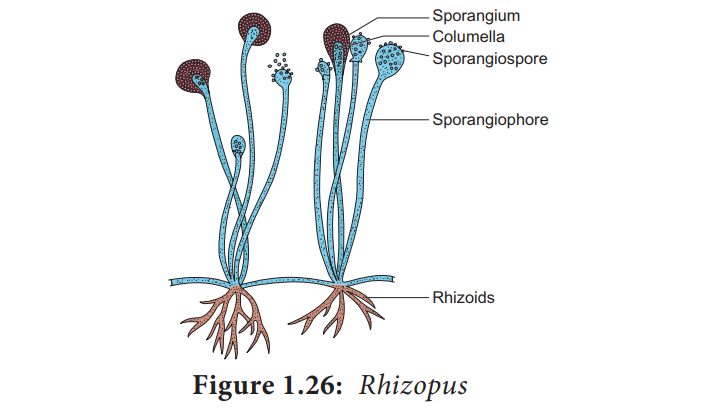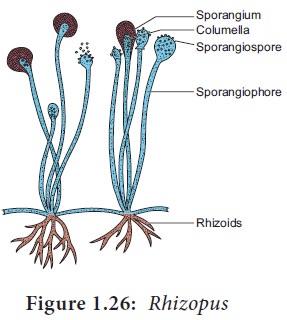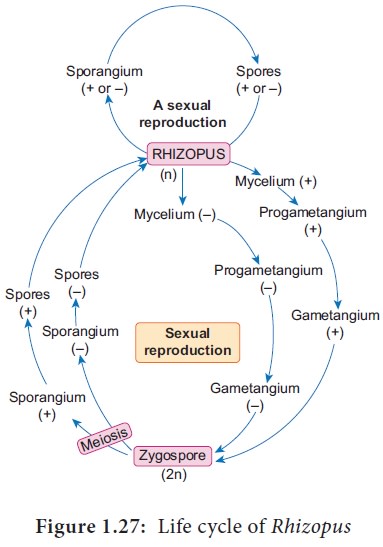Chapter: 11th Botany : Chapter 1 : Living World
Rhizopus - Fungi

Rhizopus
Class - Zygomycetes
Order - Mucorales
Family - Mucoraceae
Genus - Rhizopus
Rhizopus is a
saprophytic fungus and grows on
substrates like bread, jelly, leather, decaying vegetables and fruits. It is
commonly called ‘Bread mold’. Rhizopus
stolonifer causes leak and soft rot
of vegetables
![]()
![]()
![]()
Vegetative structure
The mycelium consists of aseptate, multinucleate (coenocyte) and profusely branched hyphae. There are horizontally growing aerial hyphae called stolons. The stolons produce rhizoids which are branched and penetrate the substratum and help in absorbing water and nutrients. Sporangiophores are borne exactly opposite to the rhizoids. The cell wall is made up of chitin and chitosan. The cell wall is followed by plasma membrane. The protoplast is granular containing many nuclei. Cell organelles like mitochondria, ribosomes and endoplasmic reticulum are present. The cell inclusions like glycogen and oil droplets are also found.
Reproduction
Rhizopus reproduces
by asexual and sexual methods.
Asexual reproduction
During favorable conditions, erect sporangiophores
are produced exactly opposite to the region of formation of rhizoids of the
mycelium. The sporangiophores are unicellular, unbranched and multinucleate
structures which bear bag like structure called sporangia. Each sporangiophore
bears a single sporangium.
Sporangium possesses a sterile region in the centre
called Columella. Spores are
produced around the columella. When the sporangial wall breaks, the columella
collapses and the spores are dispersed. When the spores fall on a suitable
substratum they germinate and produce new mycelia (Figure 1.26).

Sexual reproduction
Sexual reproduction is present and takes place
through gametangial copulation. Most of the species are heterothallic but Rhizopus sexualis is homothallic. There
is no morphological distinction between the two sexual hyphae although
physiologically they are dissimilar. Since physiologically dissimilar thalli (hyphae)
are involved in sexual reproduction, this phenomenon is called heterothallism. Mycelia which produce
gametangia are of opposite strains (+) or (-). The first step is the formation
of special hyphae called zygophores. The tips of the two zygophores swell to
form progametangia. Further, a septum is formed near the tip of each
progametangium and results in the formation of a terminal gametangium and a
suspensor cell. The two gametangia fuse, and this is followed by plasmogamy and
karyogamy. The fusion of nuclei results in the formation of a diploid
zygospore. Many nuclei belonging to opposite strains (+ or –) pair and fuse to
form many diploid nuclei. The zygospore enlarges and develops an outer thick
dark and warty layer called exine and inner thin layer called intine. After the
resting period the nuclei of zygospore undergo meiosis. The zygospore
germinates to form sporangiophores and the zygosporangium contain mixture of
(+)and (–) spores. When the spores fall on a suitable substratum, they germinate
to produce mycelium (Figure 1.20). The life cycle of Rhizopus is given in figure 1.27.




Related Topics